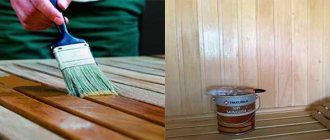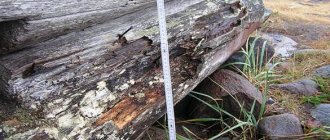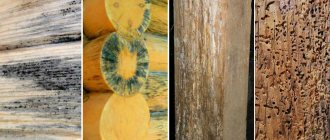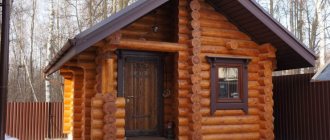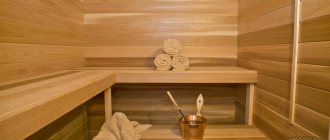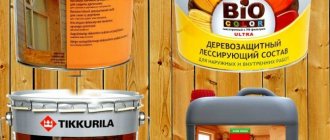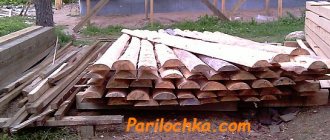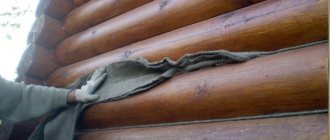How and with what to treat a log bathhouse - rules and methods of treatment
Visiting the bathhouse is an ancient tradition that has retained its relevance today due to its healing properties. Most often, bathhouses are built in suburban areas, installing a log house on the foundation.
When building a bathhouse, it is important to remember that the log house of the bathhouse needs additional protection, because inside it will be exposed to moisture, steam and high temperatures. Seasonal temperature changes and rains also harm the wood, so it is recommended to treat the outside of the log house as well. In this article we will tell you in detail how to treat the log house of a bathhouse outside and inside.
Information on choosing a tree for a log house
When choosing an impregnation or paint composition, it is necessary to take into account the type of wood from which the bathhouse is built. Some breeds do not need additional moisture protection. These species include oak and most conifers. However, each breed has its own characteristics:
- Pine does not like heat and humidity, therefore, it is not suitable for log houses.
- It is better to use spruce in a dressing room, since, despite its excellent thermal insulation properties, this tree is even more afraid of moisture than pine.
- Aspen tolerates moisture well, but gives off a bitter smell.
- Birch loves dryness, and therefore is only suitable for dressing rooms.
- Cedar and larch are not afraid of moisture, but are too resinous.
- Alder is excellent for making logs.
- Oak and ash are used to decorate expensive baths.
The resin of trees suitable for making log houses contains resins that contain phytoncides. These substances are natural antiseptics. Thus, nature itself protects such wood from fungus, rot and insect pests.
However, excessive resinity (as in some species of coniferous trees) cannot be considered a positive quality. The fact is that under the influence of high temperatures, the resin transforms into a liquid state and begins to spread. Of all the coniferous tree species, only spruce best meets the requirements for a steam room.
Special means for processing logs
First of all, it’s worth talking about the types of special impregnations that you can easily find in construction stores.
Impregnations are of the following types:
- Antiseptic agents are created to protect wood from the negative effects of moisture, for example, fungus and mold (more details: “Fungus in the bathhouse - how to get rid of it once and for all”). Such pests occur when moisture lingers for a long time on the wood and in its pores, so antiseptic impregnations penetrate deep into the wood structure and harden, preventing moisture from entering;
- Next, it’s worth talking about how to treat the log house of a bathhouse in order to protect it from fire. In this case, fire retardants will help you, which can be used indoors and outdoors. Their non-flammable composition also penetrates the pores of the wood and protects it;
- Complex impregnations are universal: they prevent the formation of mold and mildew, protect against rotting and fire. Such compositions are used outside and inside the log house.
What are the dangers of fungus formation?
Fungal spores spread an unpleasant odor and spoil wooden finishes. Fungi are also very harmful to health. Hot, humid air helps to expand the pores on the skin, through which toxins and impurities are removed. Along with the release of “garbage,” spores of “black parasites” penetrate into the body.
Household mold often forms in the bathhouse, which is considered less dangerous to humans. When the black type of mold enters the body, it causes the development of:
- Allergies. The reaction is not limited to mold. The parasite infects the body and intolerance to various irritants occurs. In most cases, a person has no idea what caused the allergy to develop.
- Diseases of the respiratory system. The respiratory organs are affected faster than other organs. Spores penetrate not only through pores, a person inhales harmful particles along with oxygen.
- Diseases of the gastrointestinal tract.
- Oncological neoplasms of benign and malignant nature.
To prevent diseases, one must constantly fight the “black infection”. If signs of fungus are detected, you need to treat the room and ventilate damp areas. If mold is not destroyed at an early stage, the benefits of visiting the steam room will be reduced to zero, and the risk of developing diseases will increase to one hundred percent.
For construction, mold is no less dangerous. If you do not start fighting the fungus, the structure of the building material will be destroyed, and the walls, floor, and ceiling of the bathhouse will begin to rot.
Classification of antiseptics
Antiseptics also have their own classification, which you must familiarize yourself with in order to choose the right way to treat the log house of the bathhouse inside or outside.
Antiseptics are divided into the following groups:
- Easily washable antiseptics are ideal for dressing rooms and rest rooms, but they are completely unsuitable for steam rooms. They contain metal salts, which will be washed out of the pores of the wood over time;
- For external treatment, it is better to use difficult-to-wash-out products made on the basis of natural and synthetic oils;
- Short-acting impregnations that easily withstand high temperatures are best suited for steam rooms. Such compositions perfectly protect not only from mold, mildew and rot, but also from bark beetles.
All these impregnations can also be divided into two groups:
- Colored impregnations . Compositions that give the wood any shade do not have any disadvantages, but they are easier to apply, because the untreated area will be distinguished by its natural color;
- Colorless impregnations . Treating a log bathhouse with this composition will be more difficult, but this way you will preserve the original color of the wood.
Compositions for treating the walls of a log bathhouse
Keeping sauna logs in good condition inside is not easy; not all existing products are suitable for these operating conditions. The main thing is that the compositions can retain their properties while in this environment. In addition, you also need to take care of the health of sauna visitors so that they do not poison their bodies with toxic fumes emanating from the chosen protective composition.
Photo: Neomid 500 wood bleach is a remedy for treating fungus-affected wood.
There is not a very large assortment of suitable means on the construction markets, but there is still plenty to choose from. You can find both imported compounds and our domestic ones. It is not worth considering that foreign products are the best, and among Russian compounds there are those whose quality is no worse, and even better in some ways. In addition, their cost is often several times lower, so is it necessary to overpay if you can save money without sacrificing quality.
Russian bathhouses have good protective equipment tested by experts and consumers. The result of using their compositions will please every customer.
How to treat a log bathhouse
Before processing the logs inside the bathhouse, you need to stock up on tools. First, prepare several brushes, because they need to be changed every 2-3 hours of work. They can treat the entire log house, but it is better to cover large areas with a spray bottle. It will allow you to do the job faster and better, but in hard-to-reach places it is significantly inferior to a brush.
There are two more ways to cover a log house with protective agents, but they are used quite rarely:
- Immersion method . This method involves completely immersing the structure in a container with an antiseptic composition. This method produces the best impregnation, but its implementation is problematic and expensive.
- Diffuse or dry processing is also used when processing logs. Compositions for this method can be presented as a powder or a thick paste.
Next, it is worth mentioning the basic processing rules:
- To ensure a reliable protective layer over the entire area of the logs, it is recommended to treat the log house before assembling it with crowns;
- Before starting to process the log house, it is recommended to clean it of various contaminants with a vacuum cleaner;
- The processed logs must be dry;
- Moisture in the bathhouse forms on almost any surface, so it is necessary to treat all the wood in the bathhouse to avoid the spread of fungus;
- Before impregnation, the bath should be cold.
The process of applying antiseptics and primers to sanded walls
After sanding the walls of the house, you need to treat them both inside and outside. The work is complex and requires material investments. Not everyone has the patience to finish it to the end.
Before applying the main layers, you should pay attention to the caulking of the log house walls. If cracks appear, re-caulk.
To seal cracks, special sealants are produced that cover the caulk and protect it from the harmful effects of the environment. If the caulking was made with natural flax fiber, then it is necessary to protect it from moisture. You can use, for example, Neomid or Remmins sealants. Only after complete caulking around the entire perimeter and its processing can you begin painting the walls.
End finishing
When processing the surface of the log house walls after grinding, you should pay special attention to the ends of the log or timber. Wood capillaries are located from top to bottom for better penetration of liquid to the crown. When sawing, these channels are exposed, and moisture from the environment easily enters them. If you treat the ends with simple sealants or an antiseptic, this will not bring the required result.
Liquid glass treatment works in a similar way, but it contains toxic substances. But it is cheap.
Any of the selected products should be applied in two layers, carefully covering all joints. Before applying the second, the first is allowed to dry.
Wall treatment
The walls are treated in the warm season at above-zero temperatures, immediately after sanding and caulking, immediately after the construction of a house made of profiled timber is completed. Grinding is best done using a grinding tool with a P80 disc. After this, the dust is removed from the logs and the first layer of antiseptic is applied, for example colorless Teknol Aqua 1410-01. Painting should be done with a brush or electric spray gun. Apply primer in two layers.
The next step is to process the walls again using a sanding machine with P220 or 240 discs. After applying the primer, hairiness appears, which is better to remove. Sanding will take a long time and requires expensive and powerful equipment. So, a high-quality cable machine costs from 2,000 rubles. And with high power, sanding a 30 cm wall takes about half an hour. Of course, you can skip this step, since it does not affect the protective characteristics.
The next step is painting with glazing compounds. You can use a covering antiseptic. The compositions must be applied in the same way using a brush or spray bottle.
To save money, instead of glazing compounds, you can use simple acrylic paint for facades. But the wood texture will be hidden. For example, acrylic paint for facades Tikurilla tolerates temperature changes well and has many shades and colors. The cost of this product is from 1,500 per 10 liters.
With high-quality processing and caulking, wooden walls will serve the owners for more than 50 years. But painting needs to be done at least once every 3-4 years. It's nice to be in a wooden house that not only looks good, but also breathes. And this can only be achieved by painting the external walls after sanding with natural and high-quality materials.
If you plan to line the interior of the log house, then you can polish the inside of the bathhouse only with a coarse abrasive. If the walls will not be sheathed with anything, then it is necessary to sand them to perfect smoothness.
It is better to carry out the initial sanding of the walls before the “finished floors” are laid and the ceiling is covered. We carry out the work in the following sequence:
- We remove the rough layer of bark with a grinder with a coarse abrasive or a grinder.
- Using a grinder, we process the groove and corner areas.
- We carry out grinding with fine abrasive material (120).
- We sand the joints of logs and the most inaccessible places by hand. To do this, the abrasive material can be wound on a block. This is a rather labor-intensive, but most effective process.
Upon completion of work on one wall, it is necessary to sweep away the dust, thoroughly vacuum the surface and coat it with an antiseptic. The same process must be repeated after complete sanding.
When starting to apply antiseptics, make sure there are no caulks. Otherwise, they can be sealed with sealants. We carry out the final finishing in this order:
- We apply a layer of antiseptic composition to protect against fungus and mold.
- After complete drying, we treat it with a glazing solution to give the room a more aesthetic appearance.
- We treat the ends with an acrylic moisture-resistant solution. Let it dry and apply a second coat.
- We coat the surface with a fire retardant to increase fire-resistant characteristics.
Profiled and laminated timber usually does not require additional leveling. It can be sanded with an eccentric machine if it is necessary to remove the top darkened layer. This process will take longer than processing with a grinder, but the result in this case is high-quality.
Copper sulfate treatment
This method is distinguished by its accessibility, because its price is quite low. The disadvantage of copper sulfate is its toxicity, which increases with heating, so it can only be used for external treatment of the bath.
To treat a bathhouse with copper sulfate you will need:
- Brushes;
- Protective equipment (rubber gloves, thick clothing and a respirator);
- Brushes with stiff bristles.
Treating the outside of the bathhouse frame with copper sulfate:
- Clean and dry the wooden surface;
- Apply copper sulfate and rub it in thoroughly;
- Wait for it to dry and apply another 3-4 layers.
Conclusion
Now you know what is used to treat a log house in a bathhouse, outside and inside. Treatment will significantly increase the service life of wood, so the time and effort spent on processing will not be wasted.
Article source: https://banyaspec.com/montazh-i-remont/kak-i-chem-obrabotat-srub-bani-pravila-i-sposoby-obrabotki.html
How to treat the inside of a bathhouse
A wooden bathhouse made of logs or timber is a great place for a country house. Wood is distinguished by high thermal insulation properties, environmental friendliness and naturalness, and safety. It does not heat up and does not burn the skin even at the highest temperatures.
At the same time, the tree looks aesthetically pleasing and harmonious, and fits into the surrounding environment. That is why wooden materials are chosen for the construction of baths or saunas. However, natural raw materials are susceptible to the negative influence of humidity and insects. In addition, wood burns very quickly.
The lower crown of the bath
The lower crown of the log house is most susceptible to rotting
The lower crown of the bathhouse is most susceptible to moisture. Therefore, it often rots very quickly. The entire frame is still in excellent condition, but it has to be replaced. What to do?
First, let's determine why the lower crown of the bathhouse rots very quickly. The causes of rotting must be determined in order to take a number of protective measures even when assembling a new log house.
The healthy condition of the lower crown is influenced by the following constructive measures when building a wooden house or bathhouse, which must be done without errors:
- a waterproofing layer of roofing felt on the surface of the concrete foundation in front of the brickwork of the base. This layer of waterproofing prevents moisture from rising from below and absorbing it into the brick material. Wet brick is not the best basis for the lower log of a log house.
- the second waterproofing layer of roofing felt is placed on the upper level of the brickwork of the base. It is the roofing felt that comes into contact with the wood of the lower crown of the log house. This contact must be made correctly.
- vents in a brick base or concrete foundation in order to provide natural ventilation in the underground.
- to prevent rainwater from getting in and stagnating on the roofing felt (see point 2), it is necessary to make a protective flashing. Its design can be different depending on the chosen material. You can simply cover the joint with a flashing board around the perimeter of the log house. You can make a drain from galvanized steel or buy it ready-made and install it so that it covers the joint and, at the same time, protects the basement part of the bathhouse from rain due to a slight offset from the outer edge of the brickwork. You can make a screed with a slope from cement-sand mortar along the upper edge of the base and stick soft tiles along it.
- Treat the lower rims with protective compounds in several layers
The absence of any of the above measures leads to rapid rotting of the casing.
The best way to avoid replacing the lower crowns is to make them from larch. Larch has the ability to harden (turn to stone) even more in the presence of moisture. It is not susceptible to fungi.
If it is not possible to get larch logs and in your region only pine is used for log houses, then you can compromise and find at least a larch board. By placing it under the lower crown, you can solve the problem of replacing the lower crowns in the same way if there were a pair of lower logs made of larch. The option is quite generous in monetary terms.
If you can’t get larch boards, then oak grows everywhere. Oak boards are a good alternative to deciduous boards. In addition, it is easier to replace the board than the lower crown.
Regarding the second point of protective measures: since the waterproofing from the roofing felt layer has a horizontal surface on which the lower log is laid, it is natural that water can stand here in puddles. Therefore, it is necessary to ensure that the surface of the roofing material is not horizontal, but has a slight slope to the outer sides to allow water to flow to the ground.
It's very easy to do:
- cut narrow strips of roofing felt approximately 5 cm wide
- put them 3-4 pieces together
- lay these roofing felt strips in the middle of the width of the plinth (or foundation)
- on top of them, place a layer of roofing felt slightly wider than the width of the plinth. (Usually a meter-wide roll of roofing felt is cut in half, resulting in a width of 500 mm, which is quite enough for waterproofing along the plinth (or foundation).
These additional soft “pads” will give you the following benefits:
- a soft “lining” will close the gaps that have formed between the log and the surface of the plinth due to unevenness of the lower surface of the log itself. In a normal situation, they are either left uncovered and the floor is raised above this joint so that it ends up underground. Or they are plugged with tow, but always from the outside; the joint is sealed with some kind of elastic sealant to prevent the tow from getting wet. This option is not entirely reliable. Better tightness is achieved through a soft “gasket”
- since in the middle it will be higher due to 5 layers of roofing material (4 narrow strips and 1 layer of a wide main strip), then the surface of the waterproofing layer will have a slope for water to drain from its surface.
Even with this design of roofing felt waterproofing, it is necessary to cover the lower crown and the upper part of the base with a galvanized or painted steel drain to prevent any moisture from getting under the lower log (see paragraph 4 of protective measures).
How to choose the right product
Natural wax, hemp and linseed oil are traditional processing materials that have not lost their relevance even now. These are safe and effective products. Today, manufacturers offer a lot of modern products that cover walls in bathhouses and houses made of logs or timber. Experts advise choosing Finnish and Russian brands.
Select products in such a way as to preserve the environmental friendliness of the structure and emphasize the aesthetic interior of a log or timber bathhouse. For a bathhouse, especially a steam room, you cannot use standard wood varnish or paint, as they do not tolerate high temperatures. When heated, such products will release an unpleasant odor and harmful toxic substances. In addition, with this treatment, the wood will not “breathe”, but will only absorb moisture and deteriorate.
Water-based and wax-based varnishes, as well as acrylic varnishes, are considered safe bath treatments. These can be colorless or colored products, with a matte or glossy sheen. For a steam room, it is better to choose a colorless varnish, and for a shower or rest room, you can take a product with a shine or tint.
The vapor permeability of the varnish must be at least 50%. This indicator reflects the ability of water vapor to pass through the surface of the varnish film. Along with the steam, the smell of wood also goes away. At the same time, the coating protects against moisture, which is not absorbed into the wood, but rolls down the wall onto the floor. As a result, the atmosphere of the bathhouse does not suffer, and the wood does not collect dirt and does not darken.
For the steam room, choose specialized, odorless products. They consist of durable components that are not destroyed when exposed to high temperatures. Classic antiseptics and varnishes are not retained in wood fibers; they soften and become sticky at temperatures above 100 degrees Celsius. In addition, this process is accompanied by the release of harmful compounds and unpleasant odors into the air. Compositions for steam rooms are developed taking into account these factors; they are safe and environmentally friendly.
Consumer Reviews
Everyone in our family loves to take a steam bath. We used to go to a public sauna weekly, but it’s not very convenient and it’s also expensive. Recently our dream came true and we became the owners of a small but cozy and most importantly our own bathhouse, which we built ourselves on the site of our country house. After construction was completed, we were faced with the problem of ensuring proper protection inside our sauna. After all, there are small children in our family, and the main thing is that they do not suffer from harmful and even dangerous fumes emanating from low-quality impregnations.
There weren’t many suitable products, so we ended up purchasing the antiseptic composition Neomid 200. We bought it for a low price, so after diluting it, we were surprised at the resulting large volume of the finished composition. Antiseptic was applied to all wooden surfaces inside the bathhouse. There was no unpleasant odor during application of the composition; there was also no foreign aroma present in the hot bath. We use our sauna several times a week, despite this the ceilings, shelves, and floors are kept in perfect condition.
Sergey Mikolyan, 30 years old.
The wooden material of the bathhouse is not subject to the easiest operating conditions; it is detrimentally affected by moisture, temperature and hot steam. But you can still extend its life using Neomid and Yaroslavl paints, which are aimed at providing effective, proper and high-quality protection for any wooden material.
How to cover walls and floors in a bathhouse
Wooden walls in the steam room and washing room are coated with acrylic varnish or oil. The steam room is painted in one layer, the washing or shower room is covered with two or three layers. Suitable products in this case are impregnations such as “Supi Saunasuoja” (Tikkurila) and “Pinotex Lacker Sauna” (Akzo Nobel).
It is recommended to varnish the walls in dry rooms, for example, in a rest room, or treat them with interior impregnation. These waterborne coatings have no foreign odors. In the MariSrub catalog you will find a wide selection of bathhouse designs, including those with rest rooms, with a second or attic floor, as well as compact one-story buildings.
The floor inside the bathhouse is exposed to the least amount of high temperatures, as hot air rises. However, the tree is most affected by water as it flows down. The emphasis in this case is on protection from rotting in a humid environment.
Floor joists are impregnated with a primer containing a powerful antiseptic, or coated with varnish that completely prevents the penetration of water into the wood. A mold repellent, antiseptic “Pinotex Impra” (Akzo Nobel) is suitable for this. It gives the effect of preserving wood. The green color of this impregnation will not be visible under the finished floor, but the coating will provide long-term protection. To preserve their natural appearance, floor boards should be treated with shelf oil without using a primer.
Effective methods of control
The process of removing fungus is labor-intensive. Various methods and means are used to combat mold. Stores offer a large number of chemical compounds that, when carefully processed, can destroy fungal spores.
Mold cleaning
Chemicals
The fight after detection is carried out using:
- Substances containing chlorine. The coating is cleaned of fungus. Some substances bleach wood materials. “Senezh” and “Rime” are considered effective. The internal surface of the bathhouse is carefully processed. In case of residual manifestations of mold, the procedure is repeated until the enemy completely disappears.
- Sulfur. The substance is ignited in a room that is previously protected from oxygen. The consumption of sulfur used is 200 grams of substance per 100 m3. To ensure that the cleansing process is safe for those around the building, the substance used is placed in a metal container. After igniting the substance, the room must be left, since sulfur vapors are harmful to humans. Returning to the steam room is permissible after nine hours. Quicklime is used to purify the air.
- Iron sulfate. The substance is mixed with table salt and potassium alum. Proportion in grams: 25:20:45. The mixture is poured with a liter of water. The composition destroys mold. After a month, the treatment should be repeated.
- Specialized products sold in hardware stores. The most effective are Metas-bio, Ceresit, Dufa, Anti-mold, Acrylit.
Mechanical cleaning is also acceptable. To eliminate fungus, you can use a spatula, sandpaper, drill brush, grinder, or iron brush. Before processing, you need to check the degree of decay of the wood. If there is a superficial lesion, treatment will help. If the wood is severely rotten, then mechanical cleaning will be useless.
Folk remedies
Folk remedies made from available substances in everyday life of every housewife help to fight the manifestation of mold:
- Vinegar. The smell is acrid, unpleasant. The substance is weakly acidic, but at the same time effectively destroys mold spores. Processing does not take much time.
- Soda. Before treatment, the substance is mixed with water to eliminate the risk of scratches. Baking soda is odorless and does not form harmful fumes at high temperatures. Does not require rinsing after treatment. The remaining substance has an antibacterial effect and prevents the re-formation of fungus.
- White. The product is effective only on a small number of affected areas. Suitable for use on surfaces made of wood, brick, and concrete.
- Hydrogen peroxide. The substance is effective even with extensive mold growth. Peroxide is able to remove fungus and protect the surface from re-formation of infection. The substance does not emit harmful fumes.
Antiseptics
Impregnations and antiseptics intended for treating bath surfaces differ in their properties and method of application. Some types are used for application to the external surface. Protect from moisture, ultraviolet radiation, dust, wind. Others are intended for interior treatment of premises. Resistant to high temperatures and high humidity. Antiseptics also protect against fire. The components contained inside the product reduce the risk of wood fire.
Special impregnations for baths can withstand high humidity and excessive temperature. The composition protects the wood from darkening. Impregnation promotes the formation of a water-repellent layer that protects against dirt. The product does not interfere with air penetration.
The solution used for treatment must be thoroughly mixed. Clean the surface and treat with the compound. When processing, you should use a brush, roller, or spray. The mixture must be applied evenly. The procedure is repeated twice with an interval of sixty minutes.
There are different types of antiseptics:
- Soluble in water. Dry powders, aqueous solutions. Safe for humans.
- Water repellent. Deep penetration. They have a strong odor. Can be applied in a well-ventilated place.
- Oil based. It is allowed to process wood during production and the preparatory stage of installation. Create a protective layer.
- Contains a solvent. Chemically aggressive substances that are harmful to health.
- Mixed formulations. Use according to instructions.
How to cover other elements
It is very important to treat benches, shelves and other pieces of furniture in the bathhouse. This will increase the service life of the products and prevent burns on the human body as a result of contact with hot surfaces. Water should not be absorbed into the wood, and at the same time, there is no need for a varnish film on the surface of objects, which, when heated, leads to burning of the skin. This coating is provided by special oils for sauna shelves, including “Supi Laudesuoja” (Tikkurila) or “Sauna Oil” (Eskaro).
Don't forget about windows and doors. The effects on these interior elements differ in each individual place of the bath:
- Window and front door. Outside temperature up to -30. Internal temperature +20;
- Door from the relaxation room to the steam room. The temperature in the room is +20, and in the steam room up to +12;
- The door from the locker room to the sink. There is normal humidity in the locker room, and water may flow down the door in the sink.
A suitable coating that can withstand such changes in temperature and humidity for a long time can only be industrial. The three-component polyurethane (varnish, hardener, thinner) system “D-Dur” (Akzo Nobel) is successfully used to protect windows and doors operated in aggressive conditions.
Strict supporters of ecology will be pleased with the technology by the presence of certificates that allow the use of varnish not only in baths, but also for more strict structures (children's furniture and toys, children's wooden utensils used for boiling water, etc.). Pinotex Base antiseptic from the same manufacturer is used as a penetrating primer.
How to apply impregnation correctly
Before applying any product, the surface is thoroughly cleaned and, if necessary, sanded. High-quality finishing of the walls and ceiling with wooden lining, and the floor with boards will increase the service life of the bathhouse. In addition, it will give the room a neat, finished appearance. However, the lining, the floorboard, and other finishing materials still need to be covered with protective agents. How to carry out interior decoration of a bathhouse or sauna, read here.
Varnish, oil or other product is applied in several layers using a roller. Difficult areas in the corners and between the crowns are treated with a brush. Each new layer is applied only after the previous one has completely dried! When using oil, remove excess product before drying. Such processing should be carried out every 4-10 years, depending on the type of materials and the quality of work. To get long-term and reliable results, turn to professionals!
“MariSrub” craftsmen will select high-quality and reliable impregnations and quickly and reliably process the bathhouse. We provide a full range of services. It includes the design and construction of a bathhouse or house with a foundation and roof, production of lumber for the project, installation and connection of utility networks, and complex finishing. We offer insulation and waterproofing of baths, protective treatment of materials in several stages! We guarantee high quality work and strict adherence to deadlines.
Source of the article: https://blog.marisrub.ru/decorating/chem-obrabotat-banyu-iznutri/
Tools and clothing
To begin with, it is important to choose the right grinding tool. Often, to carry out this procedure, a grinder with a special attachment or a special grinder is used. A lightweight model with a comfortable handle, smooth speed adjustment and rear air intake is ideal. It is more convenient to work with two machines: one with coarse, the second with fine abrasive.
As for abrasive attachments, it is preferable to choose plastic ones. They, unlike rubber ones, do not leave black marks on the wood upon accidental contact. Remember that frequently changing attachments and using the same tool can lead to overheating.
Initial grinding is carried out with discs with a grain size of 40-60. It is enough for about 4 meters of log processing. If the log house is made of coniferous wood, then it will become greasy with resin and dust. This will lead to a decrease in performance characteristics, which means it will reduce the quality of work and increase the load on the tool. Therefore, there is no need to skimp on abrasives. Secondary processing is carried out with a disk with a grain size of 100-120.
Please note that to sand rounded logs you need to use an eccentric sander. The grinder is suitable for processing timber. It is characterized by high power, and therefore can damage the wood when pressed intensely. The sander blocks the disc when pressing hard.
You can read about the bathhouse itself in my previous article How they built a bathhouse for me and in the same article there are photographs.
I was sanding logs for the first time in my life; I had never done such work before. Therefore, professionals are asked to be understanding towards the beginner. So. The grinding work inside the bathhouse took me exactly 5 days (3*4 meter bathhouse). He worked alone, from morning until late evening.
To be honest, I didn’t expect that it would take so much time, it seemed like I did a quick job with an angle grinder and that’s it. Yeah, naive, no matter how wrong it is
The following tools were used for the work: - Angle grinder (or grinder in our opinion); - Flap discs (end grinding flap wheel); - Brush with iron bristles; - Chisel or knife; - Impregnation for a wax bath (for use inside baths) brush; - A stable and reliable bench, stool; - Arms, legs, head - no matter how you look at it, there’s nowhere without it. I’ll try to tell you more about the tools during the course of the article.
You should approach your clothes with special attention, because... work is carried out indoors, there is fine and abundant dust. I have a separate set of clothes for such work. - Jeans, soft and strong. You have to work in different positions, standing, sitting, kneeling, and lying down. Thank God, at least I haven’t had to do the splits yet - The jacket is strong, made of dense material.
Since you cannot use a bathhouse during the polishing period. I decided to carry out my work without being distracted by other matters. I forgot to mention panties and socks. No matter how you look at it, they also absorb dust. Therefore my algorithm was as follows. In the morning I dress in work clothes. I work all day. In the evening I take off my clothes, take a shower (it’s not swim season yet, so you can’t go to the river), and change into clean clothes.
Click on the picture to enlarge
Respiratory/feeding/muttering protection is also needed. The first day I worked in a cap and a painting mask; I gave up the mask after an hour of work, because... impossible - the closed area heats up, sweats and generally - I didn’t like it. As a result: the cap does not cover the entire head, the ears are open, the nose and mouth too - it all becomes clogged with dust, then I was tortured to wash myself in the shower, and even then I didn’t get rid of it the first time.
On the second and subsequent days I acted more carefully. Instead of a cap, I made myself a scarf from an old sheet. Which completely covers all hair and ears. I also made a strip of the same old sheet to cover my mouth and nose, and again my ears. Those. my head was completely packed, and I had protective glasses on my eyes (to prevent my glasses from fogging up, I soaped my fingers in the morning and rubbed them from the inside over all surfaces of the glasses - it helped).
By the way, why did I mention milk and raspberry jam earlier? Not without reason. The fact is that in the bathhouse, throughout the work, all the windows and doors were open. Accordingly, there is a draft. There’s really no heat outside; when you’re working, you don’t feel the cold. But when I came home in the evening, I couldn’t warm myself up - everything was pounding, despite the warmth in the house. To avoid getting sick, I drank tea with raspberry jam at night and still had a sore throat all this time.
While working, the bitter taste of the bark in my mouth did not go away and the taste was very much reminiscent of some kind of medicine that I was given as a child. To somehow soften this taste, I drank milk often.

